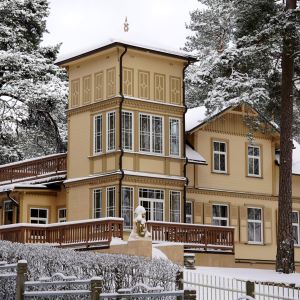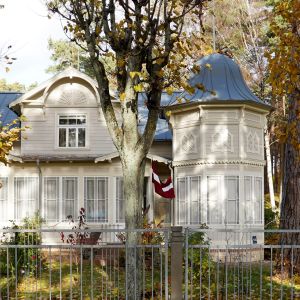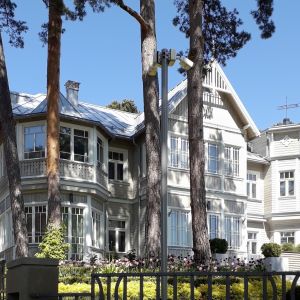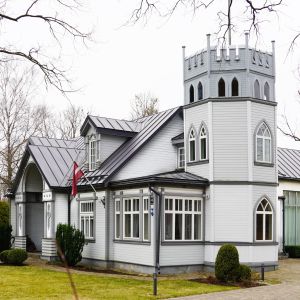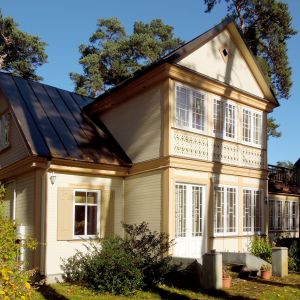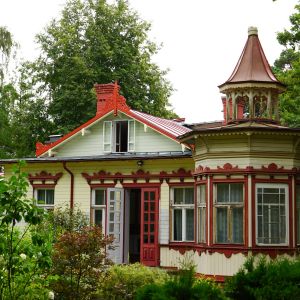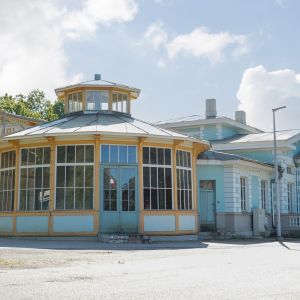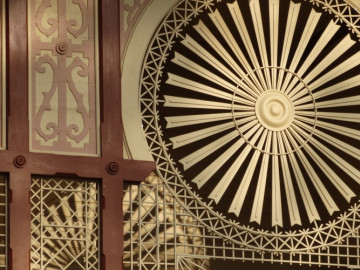The Vaivari–Asari–Melluži route

This section of the route follows the scenic Kāpu Street – the main axis of Jūrmala’s historic villa district, where historic wooden boarding houses are located along the first line of coastal dunes, in immediate proximity to the sea. Here, nature and architecture blend in remarkable harmony. Along the route, visitors can also view notable heritage landmarks – the Vaivari and Asari railway station buildings and the Melluži Open-Air Stage – the only remaining concert garden structure in Jūrmala with a shell-shaped form.
Route along Kāpu Street from Vaivari to Asari Station:
Starting point – Vaivari Station (Laimdotas Street 15) → Skautu Street (transition to Kāpu Street) → Kāpu Street 145 → 143 → 127 → 102 → 83 → Stacijas Street to Asari Station (Stacijas Street 20)
Nearby points of interest: → Dzelzceļa Street 3a → Zemgales Street 4 → Valtera Prospect 11
Route continuation to Melluži: → Mellužu Prospect and Pumpuru Street (transition to the next sightseeing area) → Kāpu Street 37 → 39a → Dārzu Street 10 No. 001
Final stop: Melluži Open-Air Stage – the only surviving concert garden structure in Jūrmala with a shell-shaped form
Additional highlight: → Strēlnieku Prospect 58, Jaundubulti (an early Art Nouveau building featuring floral woodcarving compositions)
Photos: Jūrmala Cultural Space and Environmental Design Centre
Vaivari Station, Laimdotas Street 15
Style: Classical form typical of Jūrmala’s historical wooden architecture
Volume composition:
- Asymmetrical volume
- Timber-frame construction
- Platform canopy
Look closer: Vaivari Station is a small-scale railway stop that exemplifies how architectural form can be adapted to functional needs. One side of the building serves as a platform canopy, creating a playful “cut-out” effect in the overall volume, which makes the structure both spatially generous and visually striking. Its compact scale lends a human dimension. In 2015, the building was relocated closer to Skautu Street and transformed into a café – a vivid example of adapting heritage to contemporary social needs.
Construction period: 1911
Heritage status: Local cultural monument
Kāpu Street 143
Style: Historicism
Volume composition:
- Asymmetrical volume
- Rectangular tower
Look closer: The tower features a decorative “mirror” motif popular in the late 19th century, adding a pictorial quality to the façade. Originally, the tower's loggias were open; they were later glazed. The sculpted lion with a heraldic shield at the tower’s base appeared only after the building’s reconstruction in the early 2000s.
Construction period: Late 19th century; reconstructed in early 2000s
Heritage status: Regional architectural monument
Kāpu Street 127
Style: Classical boarding house typology typical of Jūrmala
Volume composition:
- Asymmetrical volume
- Two polygonal towers
- Verandas
Look closer: The refined window muntins and façade details add a sense of elegance and lightness. Like many buildings along this street, the house is harmoniously integrated into the dune relief and features a carefully landscaped terrace garden. The street-facing façade has regained its original silhouette and delicate wooden elements after restoration, while the rear now includes a glazed volume that partially respects the historical footprint.
Construction period: Early 20th century; restored in the 2020s
Heritage status: Local cultural monument
Kāpu Street 102
Style: Classical form typical of Jūrmala’s historical wooden architecture
Volume composition:
- Symmetrical volume
- Two polygonal towers
- Veranda
Look closer: The elegant window muntins emphasize the gracefulness of the twin towers. Green has traditionally been a popular façade colour for Jūrmala's summer houses since the earliest days of the resort – its shade typically reflecting the owners' taste and means.
Construction period: Early 20th century
Heritage status: Regional architectural monument
Kāpu Street 145
Style: Art Nouveau
Volume composition:
- Asymmetrical volume
- Polygonal tower
Look closer: The tower on the main façade features a bell-shaped roof and blind woodcarved openings. The gable end facing the street is crowned with a semicircular tie beam ornamented with a sun motif.
Construction period: Early 20th century
Heritage status: Regional architectural monument
Kāpu Street 83
Style: Classical form typical of Jūrmala’s historical wooden architecture
Volume composition:
- Symmetrical volume
- Veranda
- Two-level mezzanine
- Summer kitchen extension
Look closer: Built from local pine, this structure blends seamlessly with the coastal pine grove, demonstrating true harmony between architecture and landscape. The façade is animated by a graceful wooden fretwork band on the veranda and wooden shutters.
Construction period: Turn of the 19th/20th century
Heritage status: Regional architectural monument
Asari Station Summer Ticket Booth, Stacijas Street 20
Style: Historicism
Volume composition:
- Timber-frame construction
Look closer: The polygonal wooden summer ticket booth contrasts elegantly with the station’s massive masonry arches and metal elements, creating a refined interplay of materials. The façade features finely divided glazing, supported by expressive yet simple woodcarved brackets beneath the roof. A remaining ramp section on the platform side evokes the station’s industrial past and its original 1877 station building, destroyed during the war.
Construction period: 1926 (Architect: Pēteris Feders)
Heritage status: Regional cultural monument
Dzelzceļa Street 3a
Style: Classical form typical of Jūrmala’s historical wooden architecture
Volume composition:
- Symmetrical volume
- Two-level mezzanine
- Veranda
Look closer: The façade features one of the oldest decorative techniques for summer cottages – diagonally crossed wooden slats that create a true “wooden lace” effect. The airy pattern is used above the veranda’s arched window openings, indicating the veranda was originally open.
Construction period: Early 20th century
Heritage status: Local cultural monument
Zemgales Street 4
Style: National Romanticism, Art Nouveau
Volume composition:
- Asymmetrical volume
- Plinth floor
- Tower
Look closer: The façades incorporate distinctive elements of the National Romantic style – stepped gables, curved window heads, and expressive woodcarvings. The corner tower is topped with a tented roof.
Construction period: Around 1909
Heritage status: Local architectural monument
Valtera Prospect 11
Style: Historicism
Volume composition:
- Asymmetrical volume
- Veranda
Look closer: The finely ornamented cornices cling to the roof like lace hems, giving the structure a delicate elegance. In contrast to the calm rhythm of the façade, vivid roof decorations – stylised flowers, cornices, and interconnected ornamental window frames – create visual emphasis. The polygonal corner tower is crowned by a graceful “lantern”-type superstructure.
Construction period: Early 20th century
Heritage status: Local architectural monument
Silu Street 4/8
Style: Neo-Gothic, Art Nouveau
Volume composition:
- Asymmetrical volume
- Polygonal tower
Look closer: The architecture harmoniously combines two distinct styles – Art Nouveau and Neo-Gothic. Neo-Gothic monumentality is revealed in the expressive tower, crowned with a dentil course parapet. The flowing Art Nouveau decoration enriches the façade, creating a cohesive and refined overall image.
Construction period: Approx. 1901–1912
Heritage status: Local architectural monument
Kāpu Street 39a
Style: Classical order architecture, Neoclassicism
Volume composition:
- Log construction
- Veranda
Look closer: This dwelling illustrates how vernacular craftsmanship was adapted to contemporary taste. The wooden columns display simple elegance and are crowned with a pediment featuring a semicircular lunette window. The veranda was likely added around 1910, when Neoclassicism became popular in Latvia, giving the building a modern accent for its time.
Construction period: Late 19th century
Heritage status: Local architectural monument
Kāpu Street 37
Style: Historicism
Volume composition:
- Asymmetrical volume
- Polygonal tower
- Modern extension
Look closer: This structure stands out as uncharacteristic of Jūrmala, resembling an Italian palazzo executed in wooden architecture. The façade features shutter ornaments with stylised papyrus motifs reminiscent of Art Deco. The contemporary, minimalist extension blends modern architectural language into the historic context with careful sensitivity.
Construction period: Up to 1925; renovated in 2022
Heritage status: Local architectural monument
Dārzu Street 10 No. 001
Style: Art Nouveau
Volume composition:
- Asymmetrical volume
- Plinth floor
- Square tower
- Veranda
- Balcony
Look closer: The decorative finish of the façade vividly reflects Art Nouveau influences. Nature serves as the inspiration behind details such as stylised flowers with squirrel-like profiles and a deer bas-relief placed in the gable. The richly adorned balcony with its semicircular opening forms the visual centre of the house, while the veranda’s glazing features Art Nouveau-style muntin divisions.
Construction period: 1910
Heritage status: Regional architectural monument
Melluži Open-Air Stage, Mellužu Prospect 6 k-2
Style: Art Nouveau
Volume composition:
- Symmetrical volume
- Timber-frame construction
Look closer: A true witness to Jūrmala’s historic concert life, the Melluži stage is one of the resort town’s five original open-air concert gardens – and the only one still standing. The stage’s main visual feature is its shell-type structure, with a timber frame that conveys lightness and spatial clarity. The backstage area is framed on three sides by enclosing wings.
The surrounding concert garden was designed as an orthogonal landscape composition, forming part of a 19th-century park. The Milk Pavilion facing the stage has regained its historic form after restoration, including two pergola wings on either side of the central volume.
Construction period: 1930s; restored in 2019 (Architects: Mārtiņš Jaunromāns, Māra Ābele)
Heritage status: Regional cultural monument
Strēlnieku Prospect 58 (Jaundubulti area)
Style: Art Nouveau
Volume composition:
- Asymmetrical volume
- Log construction
- Summer kitchen extension
- Plinth floor
- Square tower
- Veranda
Look closer: Still owned by descendants of the original family, this early Art Nouveau villa features unique woodcarvings in flowing, nature-inspired lines that embrace the windows, extend across the veranda panels, and continue into gable decorations. Especially notable are the floral compositions integrated into the veranda window glazing – a unique example in Jūrmala’s architectural heritage.
Construction period: Around 1900
Heritage status: National cultural monument
